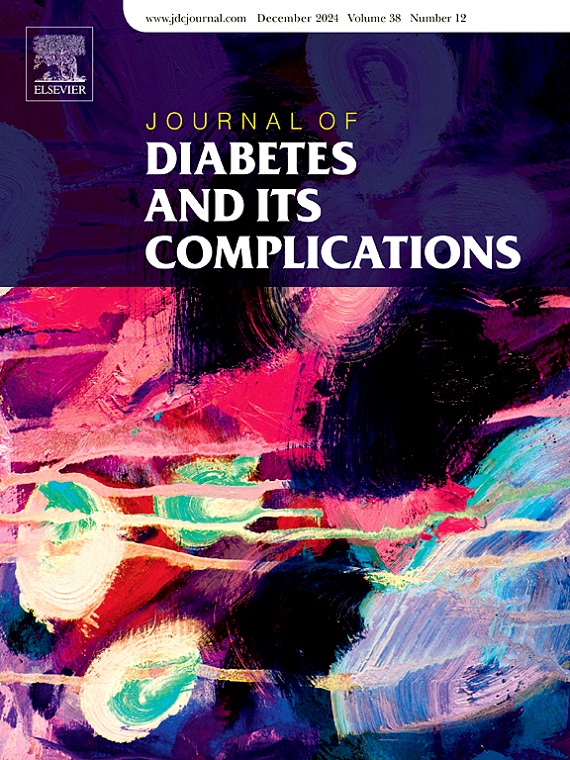Predicting the occurrence of DKA following sodium glucose co-transporter-2 inhibitors: An international cohort study
IF 3.1
3区 医学
Q3 ENDOCRINOLOGY & METABOLISM
引用次数: 0
Abstract
Background
Sodium glucose co-transporter 2 inhibitors (SGLT2i) are associated with a small-magnitude but higher risk of diabetic ketoacidosis (DKA). However, objectively identifying patients at lowest and highest risk of DKA is challenging.
Methods
We developed a prediction model using outpatient prescription data from Ontario, Canada and externally validated it using data from Denmark. We included adults with type 2 diabetes mellitus who were newly prescribed an SGLT2i. Our candidate predictors in the model were based on prior work and included the following: Sex, insulin use, prior DKA, dementia, hemoglobin A1C, and creatinine. Our outcome was 1-year risk of hospitalization with DKA. We calculated a risk score using an adaptation of penalized regression for each patient reported test characteristics in Ontario (derivation cohort) and Denmark (external validation cohort).
Results
We identified 322,135 in Ontario and 43,377 adults in Denmark who had type 2 diabetes mellitus and received an SGLT2i. The absolute risk of DKA within 1-year was 0.28 % (N = 916) in Ontario and 0.23 % (N = 101) in Denmark. Using data from Ontario, the risk score for each variable were as follows: Insulin use = 4 points, A1C > 9 % = 4 points and prior DKA = 19 points. All other variables received zero points. The overall model AUC was 63 % in Ontario and 66 % in Denmark (external validation set). Within Ontario, at a score threshold of zero, the risk of DKA was 0.19 % and the PPV was 0.3 % and the sensitivity was 100 % and similar results were observed in Denmark. For adults with a score of 19 or higher, the risk of DKA was 35-fold higher but false positives were common yielding a PPV of 6.7 % and sensitivity was lower at 3 %. In Denmark, adults with a score of 19 or higher had a risk of 11 % and the PPV was 10.2 % and sensitivity was 5 %.
Conclusion
Adults with a score of 0 (that is, simply a lack of DKA history, lack of insulin therapy, and A1c < 9 %) can be reassured that 99.8 % will not experience DKA in the subsequent year. In contrast, for adults with a score of 19 or higher the one-year risk of DKA is approximately 9 %, but false positives and false negatives are common and thus more work is needed to improve the predictive performance of the model.
预测葡萄糖共转运蛋白-2抑制剂后DKA的发生:一项国际队列研究
钠葡萄糖共转运蛋白2抑制剂(SGLT2i)与糖尿病酮症酸中毒(DKA)的小幅度但较高的风险相关。然而,客观地确定DKA风险最低和最高的患者是具有挑战性的。方法利用加拿大安大略省门诊处方数据建立预测模型,并利用丹麦门诊处方数据进行外部验证。我们纳入了新开SGLT2i的成人2型糖尿病患者。我们在模型中的候选预测因子基于先前的工作,包括:性别,胰岛素使用,既往DKA,痴呆,血红蛋白A1C和肌酐。我们的结果是1年的DKA住院风险。我们对安大略(衍生队列)和丹麦(外部验证队列)报告的每个患者的检测特征采用惩罚回归法进行了风险评分。结果:安大略省322,135例和丹麦43,377例2型糖尿病患者接受了SGLT2i治疗。安大略省1年内发生DKA的绝对风险为0.28% (N = 916),丹麦为0.23% (N = 101)。使用安大略省的数据,各变量的风险评分如下:胰岛素使用= 4分,A1C >;9% = 4分,先前DKA = 19分。所有其他变量都得零分。总体模型AUC在安大略省为63%,在丹麦为66%(外部验证集)。在安大略省,评分阈值为0时,DKA的风险为0.19%,PPV为0.3%,敏感性为100%,在丹麦也观察到类似的结果。对于得分为19或更高的成年人,DKA的风险高出35倍,但假阳性很常见,PPV为6.7%,敏感性较低,为3%。在丹麦,得分为19分或更高的成年人患乳腺癌的风险为11%,PPV为10.2%,敏感性为5%。结论:0分成人(即单纯缺乏DKA病史、缺乏胰岛素治疗、A1c <;9%的人可以放心,99.8%的人在接下来的一年里不会经历DKA。相比之下,对于得分为19或更高的成年人,DKA的一年风险约为9%,但假阳性和假阴性是常见的,因此需要更多的工作来提高模型的预测性能。
本文章由计算机程序翻译,如有差异,请以英文原文为准。
求助全文
约1分钟内获得全文
求助全文
来源期刊

Journal of diabetes and its complications
医学-内分泌学与代谢
CiteScore
5.90
自引率
3.30%
发文量
153
审稿时长
16 days
期刊介绍:
Journal of Diabetes and Its Complications (JDC) is a journal for health care practitioners and researchers, that publishes original research about the pathogenesis, diagnosis and management of diabetes mellitus and its complications. JDC also publishes articles on physiological and molecular aspects of glucose homeostasis.
The primary purpose of JDC is to act as a source of information usable by diabetes practitioners and researchers to increase their knowledge about mechanisms of diabetes and complications development, and promote better management of people with diabetes who are at risk for those complications.
Manuscripts submitted to JDC can report any aspect of basic, translational or clinical research as well as epidemiology. Topics can range broadly from early prediabetes to late-stage complicated diabetes. Topics relevant to basic/translational reports include pancreatic islet dysfunction and insulin resistance, altered adipose tissue function in diabetes, altered neuronal control of glucose homeostasis and mechanisms of drug action. Topics relevant to diabetic complications include diabetic retinopathy, neuropathy and nephropathy; peripheral vascular disease and coronary heart disease; gastrointestinal disorders, renal failure and impotence; and hypertension and hyperlipidemia.
 求助内容:
求助内容: 应助结果提醒方式:
应助结果提醒方式:


